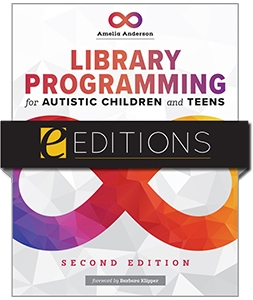
Library Programming for Autistic Children and Teens, Second Edition—eEditions PDF e-book
The download link for this product can be found on the final confirmation screen after you complete your purchase, and may also be accessed from your Account Profile. For more information about ALA eEditions file types and how to view them on eReaders, desktop computers, and other devices, see this page.
Primary tabs
You don't need to be an ALA Member to purchase from the ALA Store, but you'll be asked to create an online account/profile during checkout to proceed. This Web Account is for both Members and non-Members. Note that your ALA Member discount will be applied at the final step of the checkout process.
If you are Tax-Exempt, please verify that your account is currently set up as exempt before placing your order, as our new fulfillment center will need current documentation. Learn how to verify here.
- Description
- Table of Contents
- About the author
- Reviews
Foreword by Barbara Klipper
This second edition provides key information, updated program ideas, and practical tips that will help library workers feel more prepared to serve members of this prevalent population.
Since the first edition of this landmark guide was published, there has been increased interest in services for library patrons on the autism spectrum; indeed, more people of all ages now self-identify as autistic. Those who understand the unique characteristics of autistic young people know that ordinary library programming guides are not up to the task of effectively serving these library users. Well qualified to speak to this need, Anderson is an educator, library researcher, and former public librarian who has helped to develop two IMLS funded initiatives that train library workers to better understand and serve autistic patrons. Here, she offers librarians who work with children and teens in both public library and K-12 educational settings an updated, comprehensive resource that includes
- an updated introduction to the basics of autism, including language, symbolism, and best practices in the library rooted in the principles of Universal Design;
- step-by-step programs from librarians across the country, adaptable for both public and school library settings, that are cost-effective and easy to replicate;
- contributions from autistic self-advocates throughout the text, demonstrating that the program ideas included are truly designed with their preferences in mind;
- suggestions for securing funding and establishing partnerships with community organizations; and
- many helpful appendices, with handy resources for training and education, building a collection, storytimes, sensory integration activities, and a “Tips for a Successful Library Visit” template.
Foreword by Barbara Klipper
Acknowledgments
Introduction
How to Use This Book
Chapter 1 What Is Autism?
Chapter 2 Decisions to Make
Chapter 3 Best Practices
Chapter 4 Storytime Programs for Young Children
Chapter 5 Programming for School-Age Children
Chapter 6 Programming for Teens
Chapter 7 Programming for Families
Chapter 8 Programming in School Libraries
Appendixes
- Appendix A: Training and Education
- Appendix B: Recommended Resources for Intersectional Practice
- Appendix C: Building Your Collection
- Appendix D: Potential Funding Sources for Programs
- Appendix E: Resources for Program Support
- Appendix F: Sensory Integration Activities
- Appendix G: Keys to a Successful Library Visit
About the Contributors
Index
Amelia Anderson
Amelia Anderson, PhD, is an assistant professor of library science at Old Dominion University who has extensive experience on the topic of autism and libraries through her work as a public librarian, library researcher, and educator. Amelia has worked to develop training for librarians to better understand and serve their users on the autism spectrum through two IMLS funded initiatives, Project PALS and Project A+. Through original research and partnerships with autism self-advocates, she studies and shares best practices and trends at the intersection of autism and libraries and has presented her work at conferences from local to international audiences.
"Anderson's guidance is helpful and practical. Libraries that own the first edition and have already commenced programming will welcome this enhanced version. Librarians considering their first steps will find ample professional and personal support."
— Booklist
"One of the key features of this second edition is that it includes autistic voices and a range of resource driven appendices. Throughout the book, there are featured sections in which autistic librarians describe their opinions and experiences with library programs for autistic children and teens. This book also extensively describes best practices for how to make public library services for children and youth more inclusive, not just for users with ASD, but for all neurodiverse people and individuals with developmental disabilities ... [This book] unequivocally achieves its purpose of providing guidance, best practices, and examples of successful library services for autistic children and youth to public and school librarians and library staff. I would highly recommend any public librarians and staff read this book before starting to offer library services and programs for children and youth with autism."
— The International Journal of Information, Diversity, & Inclusion


